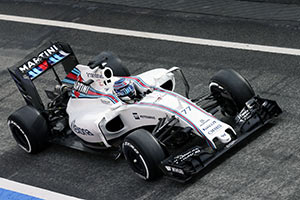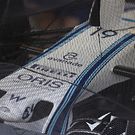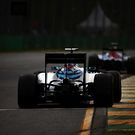Williams FW38 Mercedes

Active: 22-02-2016 - 2016
Team: Williams F1
Team: Pat Symonds (CTO), Rob Smedley (Head of Performance Engineering), Jason Somerville (HA), Ed Wood (CD), Claire Williams (DTP), Frank Williams (TP), Mike O'Driscoll (Group CEO)
Drivers: Felipe Massa (19), Valtteri Bottas (77), Alex Lynn (Development)
Team name: Williams Martini Racing
The Williams FW38 was first fired up at the team's factory in Grove in the evening of 19 January, considerably ahead of the schedule that the team was on in the 2015 season. Williams underlined that this was mostly the result of continuity, as the team's main figures, as well as its driver line-up remained unchanged. Still, by the time it broker cover on the first day of testing at Barcelona, on 22 February, Claire Williams was quick to say it was far from the finished product.
Indeed, the launched car featured the exact same nose cone as its predecessor, and it soon emerged that the team was still working on an updated design for the start of the season. Similarly, the front suspension remained the same, as well as the initial shape of the sidepods, despite featuring slightly smaller air inlets, thanks to an improved cooling system on the new Mercedes engine.
Most of the team's efforts over the winter however initially went into development of the rear end. The team had found out early in 2015 that its FW37 was by no means as competitive in slow corners as it was in high speed ones, resulting in very difficult races at circuits like Monaco and Hungary.
Pat Symonds confirmed the problems at the launch of the FW38: "The FW37 was a pretty effective car and so we concentrated on understanding the areas where we could improve it without losing the attributes which made it effective. It is no secret that the low speed performance of the FW37 didn’t match its high speed performance so a lot of time was spent looking into why this was and subsequently making changes, which we hope will improve the situation. On top of this we looked at the normal physical obstacles to development that one always meets during the life of a car and tried to push those barriers back."

At the time of its launch, rear end changes were however obvious, with the team almost copying an airflow conditioner behind and over the rear suspension arms. This carbon fibre loop (it's leading edge marked in yellow), connected each side on the car's floor, helps to stabilize airflow coming from within and around the sidepod to enhance the efficiency of the rear diffuser.
The team also strangely opted to have two wastegate pipes, fairly distant from the main tailpipe (main tailpipe and right hand side wastegate tailpipe marked in green). Other teams chose to the the pipes closer to one another, but Williams chose to retain the rear wing pylon that wraps closely around the main exhaust pipe, forcing the wastegate pipes to be a little further away from the main exhaust.
Season progress
Once on track however, it was clear that Williams had not made a step forward. The contrary was true. Technical chief Pat Symonds conceded mid-season that development had not been strong enough while Valtteri Bottas said Williams had lost performance in high-speed corners while improving in low-speed ones.
The FW38 was as such good enough for just a single podium finish, thanks to Valtteri Bottas taking third at the Canadian Grand Prix. Williams finished the season 5th in the constructors' championship, losing 4th to Sahara Force India towards the end of the season.
Specifications
Chassis: Carbon-fibre monocoque
Front suspension: Upper and lower wishbones, inboard springs and dampers actuated by push-rods
Rear suspension: Upper and lower wishbones, inboard springs and dampers actuated by pull-rods
Dampers: Williams
Brakes: AP 6 piston front and 4 piston rear calipers with carbon discs and pads
Transmission: Williams eight speed seamless sequential semi-automatic shift plus reverse gear, gear selection electro-hydraulically actuated
Clutch: Carbon fibre plates
Electronics: FIA standard ECU and FIA homologated electronic and electrical system (as provided by MES)
Cooling system: Aluminium oil, water and gearbox radiators
Tyres: Pirelli, Fronts: 245/660-13, Rears: 325/660-13
Wheels: Apptech, forged magnesium alloy
Fuel system: ATL Kevlar-reinforced rubber bladder
Dimensions
Length: 5,000 mm
Height: 950 mm (minus T camera)
Track width: 1,460 mm (front); 1,416 mm (rear)
Weight: 702kg (FIA mininum; incl. driver and lubricants, tank empty)
Powertrain
Designation: Mercedes-Benz PU106C Hybrid
Type: Turbocharged, 90° 1.6l V6, assisted with kinetic and heat ERS
No of valves: 24 (4 per cylinder)
Fuel injection: High-pressure direct injection (max 500 bar, one injector/cylinder)
Pressure charging: Single-stage compressor and exhaust turbine on a common shaft
Bore: 80mm
Stroke: 53mm
Crank height: 90mm (minimum allowed)
Energy recovery system: Integrated Hybrid energy recovery via electrical Motor Generator Units
Energy Store: Lithium-Ion battery solution, between 20 and 25 kg
Fuel: PETRONAS Primax
Lubricants: PETRONAS Syntium
Gearbox & hydraulic oil: PETRONAS Tutela
Power: In excess of 900bhp






